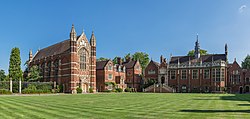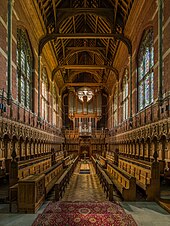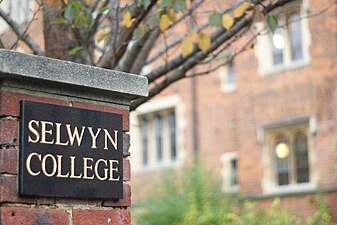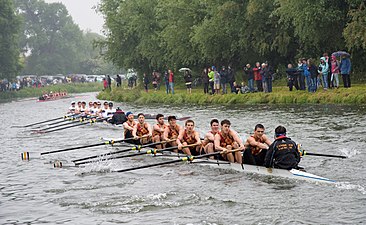Selwyn College, Cambridge: Difference between revisions
Created page with "{{Infobox college |name=Selwyn College |county=Cambridgeshire |university=Cambridge |picture=Selwyn College Old Court, Cambridge, UK - Diliff.jpg |picture caption=Selwyn Colle..." |
No edit summary |
||
| Line 12: | Line 12: | ||
|livery=A3C1AD | |livery=A3C1AD | ||
|headtext=black | |headtext=black | ||
|arms=Selwyn College | |arms=Selwyn College, Cambridge arms.svg | ||
|scarf={{scarf|#772233|10|#eebb44|3|#772233|4|#eebb44|1|#772233|4|#eebb44|3|#772233|10}} | |scarf={{scarf|#772233|10|#eebb44|3|#772233|4|#eebb44|1|#772233|4|#eebb44|3|#772233|10}} | ||
|motto=Ανδρίζεσθε | |motto=Ανδρίζεσθε | ||
Latest revision as of 22:47, 12 April 2024
| Selwyn College
| |||||||||||||||
|
Ανδρίζεσθε | |||||||||||||||
|---|---|---|---|---|---|---|---|---|---|---|---|---|---|---|---|
 Selwyn College's Old Court | |||||||||||||||
 | |||||||||||||||
| Master: | Roger Mosey | ||||||||||||||
| Website: | www.sel.cam.ac.uk | ||||||||||||||
| |||||||||||||||
| Location | |||||||||||||||
| Grid reference: | TL44035798 | ||||||||||||||
| Location: | 52°12’4"N, -0°6’22"E | ||||||||||||||
Selwyn College (formally Selwyn College in the University of Cambridge) is a constituent college of the University of Cambridge. The college was founded in 1882 by the Selwyn Memorial Committee in memory of George Augustus Selwyn (1809–1878), the first Bishop of New Zealand (1841–1868), and subsequently Bishop of Lichfield (1868–1878). Its main buildings consist of three courts built of stone and brick (Old Court, Ann's Court, and Cripps Court). There are several secondary buildings, including adjacent townhouses and lodges serving as student hostels on Grange Road, West Road and Sidgwick Avenue. The college has some 60 fellows and 110 non-academic staff.
In 2019, Selwyn was ranked eighth on the Tompkins Table of Cambridge colleges in order of undergraduates' performances in examinations,[1] having been first in 2008.[2]
History
George Augustus Selwyn
The college was founded following the death of Bishop George Augustus Selwyn, who had played an important role in the establishment of New Zealand as its first bishop. Selwyn was a scholar of St John's College, Cambridge, and a member of the Cambridge crew which competed in the inaugural Boat Race in 1829. After teaching at Eton College he was ordained and when in 1841 an episcopal council held at Lambeth recommended the appointment of a bishop for New Zealand, they offered the post to Selwyn.
He returned to Britain in 1867, and accepted the post of Bishop of Lichfield, which he held until his death on 11 April 1878, aged 69.

The Selwyn College coat of arms incorporates the arms of the Selwyn family impaled with an adaptation of the arms of the Diocese of Lichfield. The arms were granted in the 1960s.
The college motto is a biblical quotation from 1 Corinthians chapter 16, verse 13, in Greek: ΑΝΔΡΙΖΕΣΘΕ[3] (andrízesthe), translated in the King James Version as "Quit ye like men". A longer extract of the verse, "ΣΤΗΚΕΤΕ ΕΝ ΤΗ ΠΙΣΤΕΙ ΑΝΔΡΙΖΕΣΘΕ", is carved over the main College gate (the full Greek verse of 1 Corinthians 16:13 being Γρηγορεῖτε, στήκετε ἐν τῇ πίστει, ἀνδρίζεσθε, κραταιοῦσθε).
Foundation of the College
After Selwyn's death in 1878, a number of scholars from Cambridge launched plans to establish a college to honour his life. The Selwyn Memorial Committee was founded with Charles Abraham (Bishop of Wellington) as secretary, and it proposed that a Cambridge college should be established as a memorial. The college's first Master, Arthur Lyttelton, was formally elected on 10 March 1879, the Archbishop of Canterbury Archibald Tait was invited to become Visitor on 28 June 1878 and building of Old Court, as it is now known, began in 1880.
The foundation stone of the college was laid by Edward Herbert, 3rd Earl of Powis in a ceremony on 1 June 1881, following a lunch in King's College, Cambridge. A Charter of Incorporation was granted by Queen Victoria on 13 September 1882, and the west range of Old Court was ready for use by the college's official opening (with the Master's installation) on 10 October 1882, in time for Michaelmas term. Selwyn's first 28 undergraduates joined the original master and 12 other Fellows at the then Public Hostel of the university in 1882.
The first master of the college was Arthur Lyttelton, who sought to establish the college on a firm academic and financial foundation. Lyttelton had been senior tutor at Keble College, Oxford. He came from a well-established family with strong connections in both Church and State, his mother being the sister-in-law of the prime minister, William Ewart Gladstone, who became a major benefactor of the college. Lyttelton was himself a life-long supporter of the Liberal party and was familiar with many politicians in Westminster, his wife Kathleen, a women's activist, being the daughter of the Liberal MP George Clive. Lyttelton persuaded Gladstone to make a personal gift to the college of the louder of the two chapel bells. Gladstone reportedly believed that Cambridge students needed to be well woken if they were to get up at a productive time in the morning. Today, the chapel bell is known as 'Gladstone's Bell' by students.

The college was founded by donations and subscriptions, with a distinctly religious character. The royal charter for the college, reproducing the terms of the charter of Keble College, was sealed on 13 September 1882. The charter declared that the college was "founded and constituted with the especial object and intent of providing persons desirous of academic education and willing to live economically with a College wherein sober living and high culture of the mind may be combined with Christian training based upon the principles of the Church of England". Initially, only baptised Christians were accepted as students or scholars. The original foundation charter specified that the college should "make provision for those who intend to serve as missionaries overseas and ... educate the sons of clergymen".
Collegiate status
From its foundation, Selwyn was not yet a full college of the university, but a "Public Hostel", with its undergraduates regarded as non-collegiate and marked with the designation "H. Selw." on Senate House lists.
In 1926 the "Public Hostel" status was abolished, replaced with that of "Approved Foundation", granting more security to the college. The distinction of the college as "H. Selw." on Senate House lists had also ceased from June 1924.
On 14 March 1958, Selwyn was granted full collegiate status.
Selwyn, in common with most other Oxford and Cambridge colleges, originally admitted only men, but was one of the first colleges to become mixed when women were admitted from 1976. In that year, women lived only on E and H Staircases, but in subsequent years could live anywhere in College. In 1999, Selwyn appointed the first female Director of Music in an Oxbridge College, Sarah MacDonald, and in 2009, Selwyn became the first Cambridge college to appoint a female head porter, Helen Stephens.[4]
Development
The college founders purchased from Corpus Christi College six acres of land which lay between Grange Road, West Road and Sidgwick Avenue on 3 November 1879 at a cost of £6,111 9s 7d. This parcel of land is still owned by the college and is the location of Old Court and Ann's Court. The site was originally considered somewhat remote from the centre of the university, but Selwyn now neighbours the Sidgwick Site where several of the university's arts and humanities faculties are. An alternative site on Lensfield Road, where Our Lady and the English Martyrs Church now stands, was considered but rejected as too small.
The chapel was built in 1895 before the dining hall (in 1909), and chapel attendance was compulsory for students from the college's foundation until 1935. There were originally plans to build a permanent library between F Staircase and the chapel to complete Old Court, on land that now forms part of the College Gardens, but this was not done. The Selwyn College Library was opened in 1929, funded by subscriptions in honour of college members who had died in the First World War. In 1894 and 1896, respectively, the Old Library in the tower, received two extensive benefactions of history, politics and theological texts, from Canon William Cooke and Edward Wheatley-Balme. These large literary bequests gave Selwyn College an excellent working library.
The Jacobean-style Dining Hall was constructed under the tenure of the fourth Master of Selwyn College, Richard Appleton, who had previously been a senior fellow of Trinity College, Cambridge. His appointment as Master continued the close relationship between Selwyn and Trinity which had been supportive of the younger college. Appleton served for two years from 1907 before he died of influenza. Despite his brief mastership, Appleton had managed to secure funding for the Dining Hall. Appleton's initials and rebus (three apples and a tun) appear on the north wall of the Hall entrance, and his posthumously painted portrait hangs in the college. Construction on the dining hall began in 1909, but Appleton did not live to see the project completed.
The dining hall was always intended to be panelled, however, this vision could not be realised until the woodwork for the west side of the hall was presented in 1913 by the Magdalene fellow, A. C. Benson in memory of his father Archbishop Benson. This panelling came from the English Church in Rotterdam which was designed by the office of Sir Christopher Wren between 1699 and 1708.
University education was expensive at the time of Selwyn's foundation, and given that Selwyn College was intended to be a place for young students who could not otherwise afford an Oxbridge education, the college charges were initially kept low. Undergraduates initially paid £27 per term for food, lodgings, lectures and tuition, with a small surcharge for students of medicine, scientists and engineers. This was raised to £28 in 1916, and £33 in 1918, as the number of scholars studying at Oxford and Cambridge drastically decreased due to the First World War.

Buildings and grounds
Old Court, construction of which began in 1880 and is built in Ketton stone and local red brick in the Victorian Late Perpendicular Gothic Revival style, was largely designed by Sir Arthur Blomfield and comprises seven staircases (A–G), together with a tower and gateway, Master's Lodge, Chapel, Hall, Kitchens, Music Practice Room and Archives. Selwyn College Library is located adjacent to Old Court; it was designed by T. H. Lyon in 1929 to serve as a First World War memorial.
Cripps Court, named after the Cripps Foundation that donated most of the funds to build it (and which also funded developments at St John's College, Queens' College and Magdalene College) was built and formally opened on 17 May 1969 on land on the opposite side of Grange Road which was originally owned by Jesus College. Selwyn's Cripps Court features a tricolon design with ensuite rooms for students. Cripps Court comprises a further seven staircases (H–N) and is home to all of Selwyn's first-year undergraduates, a few second-year undergraduates and postgraduates including their common room, the Middle Combination Room (MCR).


Ann's Court, built on the land to the north of Old Court and south of West Road, is the most recent court. Its exterior reflects the atmosphere of the rest of the college with Ketton limestone and brick-work fixtures. Ann's Court was designed by the traditionalist architect Demetri Porphyrios who has completed similar new projects at Magdalen College, Oxford, which also utilised hand-carved Ketton stone in its exteriors, and at Princeton University (Whitman College) in the United States. The golden-yellow Ketton stone used in Ann's Court (and the rest of Selwyn College) has been used in the construction of Oxford and Cambridge colleges for several hundred years, and can be seen in the exterior of the Wren Library at Trinity College. The interior of Ann's Court is contemporary and equipped with wooden staircases. As a proponent of New Classical Architecture, Porphyrios designed new buildings which fit the existing limestone and brick materials of Selwyn College. The Porphyrios Associates design involved a three-winged building which created the space for a large new court to be formed in the middle of the college, named Centre Court. Ann's Court features hand-carved details and a series of limestone cloisters and chimneys arranged in the traditional Cambridge University fashion. Ann's Court was named after Ann Dobson, who with her husband Christopher Dobson (who matriculated at Selwyn in 1957) formed the Ann Dobson Foundation, which is one of the principal donors towards the construction costs of Phases I and II. Phase I was completed in July 2005 and consists of 43 ensuite rooms and 15 administrative offices, forming two staircases (O and P) at a cost of £7.5 million. The second phase, including 40 en-suite bedrooms forming staircases Q and R and a new Junior Combination Room at a cost of £2.5 million, was completed in Summer 2009.[5] The college bar was refurbished in 2002, and redecorated in 2011.
Pictures
-
Selwyn College entrance
-
Selwyn College Hall
-
Selwyn College Chapel interior
-
Selwyn College Chapel exterior
-
Old Court
-
Selwyn College Cloisters
-
Selwyn College Boat Club in the 2015 May Bumps
-
Selwyn College Boat Club in 1914
-
Selwyn College Old Boat House
Outside links
| ("Wikimedia Commons" has material about Selwyn College, Cambridge) |
- Selwyn College
- Selwyn College JCR Committee
- Selwyn College MCR
- Selwyn Snowball
- Selwyn College Boat Club
- Selwyn Alumni
References
- ↑ "Exclusive: Christ's triumphant in 2019 Tompkins Table". https://www.varsity.co.uk/news/17736.
- ↑ Garner, Richard (28 July 2008). "'Poorer' college tops Cambridge degree table". The Independent. https://www.independent.co.uk/news/education/education-news/poorer-college-tops-cambridge-degree-table-878699.html.
- ↑ 1w Corinthians 16. Users.cs.york.ac.uk. Retrieved 22 December 2013.
- ↑ "Cambridge College first as Helen is appointed". This is South Wales. 9 September 2009.
- ↑ Kilpatrick, Heather (June 2009). Selwyn College Cambridge – Ann's Court: The story so far. Selwyn College Cambridge.
| Colleges of the University of Cambridge | |
|---|---|
|
Christ’s • Churchill • Clare • Clare Hall • Corpus Christi • Darwin • Downing • Emmanuel • Fitzwilliam • Girton • Gonville and Caius • Homerton • Hughes Hall • Jesus • King’s • Lucy Cavendish • Magdalene • Murray Edwards • Newnham • Pembroke • Peterhouse • Queens’ • Robinson • St Catharine’s • St Edmund’s • St John’s • Selwyn • Sidney Sussex • Trinity • Trinity Hall • Wolfson |
 |









